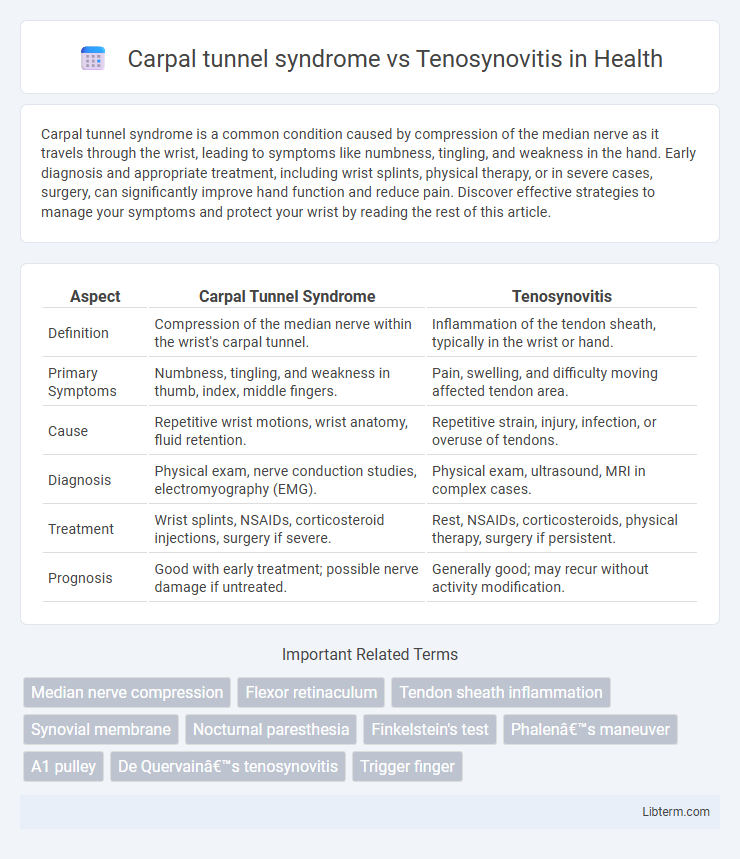Carpal tunnel syndrome is a common condition caused by compression of the median nerve as it travels through the wrist, leading to symptoms like numbness, tingling, and weakness in the hand. Early diagnosis and appropriate treatment, including wrist splints, physical therapy, or in severe cases, surgery, can significantly improve hand function and reduce pain. Discover effective strategies to manage your symptoms and protect your wrist by reading the rest of this article.
Table of Comparison
| Aspect | Carpal Tunnel Syndrome | Tenosynovitis |
|---|---|---|
| Definition | Compression of the median nerve within the wrist's carpal tunnel. | Inflammation of the tendon sheath, typically in the wrist or hand. |
| Primary Symptoms | Numbness, tingling, and weakness in thumb, index, middle fingers. | Pain, swelling, and difficulty moving affected tendon area. |
| Cause | Repetitive wrist motions, wrist anatomy, fluid retention. | Repetitive strain, injury, infection, or overuse of tendons. |
| Diagnosis | Physical exam, nerve conduction studies, electromyography (EMG). | Physical exam, ultrasound, MRI in complex cases. |
| Treatment | Wrist splints, NSAIDs, corticosteroid injections, surgery if severe. | Rest, NSAIDs, corticosteroids, physical therapy, surgery if persistent. |
| Prognosis | Good with early treatment; possible nerve damage if untreated. | Generally good; may recur without activity modification. |
Introduction to Carpal Tunnel Syndrome and Tenosynovitis
Carpal tunnel syndrome involves compression of the median nerve within the wrist's carpal tunnel, leading to symptoms such as numbness, tingling, and weakness in the hand. Tenosynovitis is characterized by inflammation of the tendon sheath, often causing pain, swelling, and difficulty moving the affected joint. Both conditions frequently affect the wrist and hand but differ in their underlying pathophysiology and treatment approaches.
Defining Carpal Tunnel Syndrome
Carpal Tunnel Syndrome (CTS) is a condition caused by compression of the median nerve as it travels through the carpal tunnel in the wrist, leading to symptoms such as numbness, tingling, and weakness in the hand. Unlike Tenosynovitis, which involves inflammation of the tendon sheaths, CTS specifically affects the nerve pathways, resulting in nerve-related symptoms. Accurate diagnosis often involves nerve conduction studies and clinical examination to differentiate CTS from other conditions like Tenosynovitis.
Understanding Tenosynovitis
Tenosynovitis is the inflammation of the synovial sheath surrounding a tendon, commonly affecting the wrists and hands, leading to pain, swelling, and restricted movement. Unlike Carpal Tunnel Syndrome, which involves median nerve compression causing numbness and tingling, Tenosynovitis results primarily from repetitive strain or infection impacting tendon mobility. Effective diagnosis relies on clinical examination and imaging such as ultrasound or MRI to differentiate between tendon sheath inflammation and nerve compression conditions.
Key Differences in Causes
Carpal tunnel syndrome primarily results from the compression of the median nerve within the carpal tunnel due to repetitive hand movements, wrist anatomy, or inflammation. Tenosynovitis is caused by inflammation of the synovial sheath surrounding a tendon, often triggered by repetitive motions, infections, or autoimmune conditions. While carpal tunnel syndrome involves nerve impingement, tenosynovitis centers on tendon sheath inflammation, highlighting distinct pathological origins.
Comparing Symptoms and Clinical Presentation
Carpal tunnel syndrome presents with numbness, tingling, and pain in the thumb, index, middle, and ring fingers, often worsening at night due to median nerve compression. Tenosynovitis typically causes localized tenderness, swelling, and a squeaking sensation during joint movement, primarily affecting the flexor tendons of the wrist or fingers. Unlike the nerve-related symptoms of carpal tunnel syndrome, tenosynovitis is characterized by inflammation of the tendon sheath and may result in limited range of motion without sensory disturbances.
Diagnosis: Carpal Tunnel Syndrome vs Tenosynovitis
Diagnosis of Carpal Tunnel Syndrome (CTS) typically involves nerve conduction studies and electromyography to assess median nerve compression, whereas Tenosynovitis diagnosis relies on clinical evaluation of tendon sheath inflammation and imaging techniques like ultrasound or MRI. CTS presents with symptoms such as numbness, tingling, and weakness in the thumb, index, and middle fingers, while Tenosynovitis manifests as pain, swelling, and restricted tendon movement, commonly around the wrist or hand. Differential diagnosis is crucial to distinguish between nerve entrapment in CTS and inflammatory tendon sheath conditions in Tenosynovitis for targeted treatment.
Treatment Options for Both Conditions
Carpal tunnel syndrome treatment primarily involves wrist splinting, corticosteroid injections, and, in severe cases, surgical decompression to relieve median nerve pressure. Tenosynovitis treatment focuses on resting the affected tendon, nonsteroidal anti-inflammatory drugs (NSAIDs), corticosteroid injections, and physical therapy to reduce inflammation and restore mobility. Both conditions may benefit from ergonomic adjustments and activity modifications to prevent recurrence and promote healing.
Prevention and Risk Factor Management
Effective prevention of Carpal Tunnel Syndrome (CTS) and Tenosynovitis centers on ergonomic workplace adjustments, including proper wrist positioning and frequent breaks to reduce repetitive strain. Managing risk factors involves controlling systemic conditions such as diabetes and rheumatoid arthritis, which increase susceptibility to both conditions. Incorporating wrist splints during activities and maintaining muscle strength through targeted exercises can further mitigate the risk of developing nerve compression or tendon inflammation.
Prognosis and Long-term Outcomes
Carpal tunnel syndrome typically presents a favorable prognosis with early intervention, including splinting, corticosteroid injections, or surgery, allowing most patients to regain full hand function and experience symptom relief. Tenosynovitis prognosis varies based on etiology; acute cases often resolve completely with rest and anti-inflammatory treatment, whereas chronic or repetitive strain-induced tenosynovitis may lead to persistent pain or functional impairment if untreated. Long-term outcomes for both conditions depend on prompt diagnosis and management, with delayed treatment increasing the risk of nerve damage in carpal tunnel syndrome and tendon degeneration in tenosynovitis.
When to Consult a Healthcare Professional
Persistent numbness, tingling, or weakness in the hand and fingers may indicate Carpal Tunnel Syndrome, warranting prompt consultation with a healthcare professional for nerve conduction studies and early intervention. In contrast, Tenosynovitis typically presents with localized pain and swelling along a tendon, and medical evaluation is essential when symptoms persist beyond a few days or impair hand function. Early diagnosis and treatment of both conditions are crucial to prevent long-term damage and improve recovery outcomes.
Carpal tunnel syndrome Infographic

 libterm.com
libterm.com